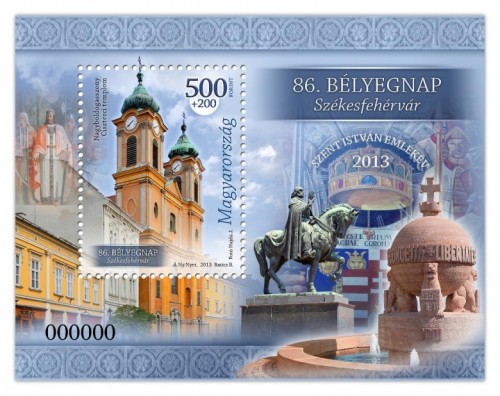
1. MAGYAR - 83. BÉLYEGNAP - SZÉKESFEHÉRVÁR - BLOKK - Bélyeg vásárlás >>
2. ENGLISH - 86TH STAMP DAY - SZÉKESFEHÉRVÁR - BLOCK - Order stamp >>
3. GERMAN - 86. TAG DER BRIEFMARKE - SZÉKESFEHÉRVÁR - BLOCK - Die Bestellnummer Der Marke >>
1. MAGYAR - 83. BÉLYEGNAP - SZÉKESFEHÉRVÁR - BLOKK
A Szent István Emlékév programsorozat keretében 2013. április 26-28. között Székesfehérvár ad otthont a 86. Bélyegnap eseményeinek és a HUNFILA 2013 – Székesfehérvár Nemzetközi Bélyegkiállításnak. A Magyar Posta az idei bélyegnapra hagyományosan feláras bélyegblokkot és kétcímletű bélyegsorozatot hoz forgalomba. A felárból befolyó összeget, blokkonként 200 Ft-ot, a Magyar Posta a hazai szervezett bélyeggyűjtés támogatására fordítja. A bélyegnapi újdonságok Hajdú József fotóinak felhasználásával Baticz Barnabás tervei alapján készültek az ANY Biztonsági Nyomdában.
A blokk bélyegképén a székesfehérvári Nagyboldogasszony Ciszterci templom, keretrajzán pedig Székesfehérvár nevezetességei közül látható néhány. A 85 Ft-os címleten Bory Jenő: Püspökkút c. alkotásának részletei, Asztrik, és a kompozíció csúcsalakja látható. A 110 Ft-os bélyeg hátterében a székesfehérvári Városháza, előtte az épület erkélyének bal oldali Justitia szobra látható. Az ívszéleken a „Székesfehérvár, a királyok városa” felirat szerepel.
Székesfehérvár, a királyok városa; püspöki székhely, történelmi, kulturális és gazdasági központ. Székesfehérvár az ország egyik legrégibb városa, a Dunántúl második legnagyobb kiterjedésű települése, Fejér megye székhelye. Szent István halála után, 1038-1543-ig mind a negyvenhárom magyar királyt Fehérvár falai között koronázták meg; a székesfehérvári Bazilikát pedig tizenöt Árpád-házi- és hét vegyesházi király választotta végső nyughelyéül. Egy XV. századból származó emlékirat szerint: „A magyaroknak három törvényük van. Úgy hiszik, hogy bármelyiket hagyja teljesítetlenül valaki, az már nem törvényes király. Az első törvény úgy szól, hogy a királyt a Szent Koronával kell megkoronázni. A második, hogy az esztergomi érseknek kell megkoronáznia. A harmadik, hogy a koronázásnak Fehérvárott kell megtörténnie.” Forrás: szekesfehervar.hu; utazok.hu
Forrás: Posta
2. ENGLISH - 86TH STAMP DAY - SZÉKESFEHÉRVÁR - BLOCK
As part of the series of events marking the St Stephen Memorial Year, Székesfehérvár is hosting the events of the 86th Stamp Day and the HUNFILA 2013 – Székesfehérvár International Stamp Exhibition between 26 and 28 April 2013. Magyar Posta is issuing its traditional stamp block with a surcharge and a two denomination set of stamps for this year’s Stamp Day. Magyar Posta devotes the HUF 200 surcharge on each block to supporting organised stamp collecting in Hungary. The Stamp Day novelties, designed by Barnabás Baticz based on photographs by József Hajdú, were printed by the ANY Security Printing Company.
The design of the block’s stamp features the Cistercian church of Our Lady in Székesfehérvár and some of the sights of the city appear in the border. Details of Jenő Bory’s Bishops Fountain, Saint Astrik of Pannonhalma and the top of the composition, are shown on the HUF 85 stamp. The city hall of Székesfehérvár provides the background for the HUF 110 stamp with the statue of Justice from the left side of the building’s balcony occupying the foreground. The selvedge bears the inscription in Hungarian “Székesfehérvár, city of kings”.
Székesfehérvár, the city of kings, is an episcopal seat, and a historic, cultural and economic centre. It is one of Hungary’s oldest cities, the second most extensive city in Transdanubia and the county seat of Fejér county. After the death of Saint Stephen, all forty-three Hungarian kings between 1038 and 1543 were crowned in the city, and the Basilica is the last resting place of fifteen kings from the House of Árpád and seven kings from other houses. According to a 15th-century document: “Hungarians have three laws. It is believed that, if any of the three laws is not fulfilled, the king is not the rightful monarch. The first says that the king has to be crowned with the Holy Crown of Hungary. The second that he has to be crowned by the Archbishop of Esztergom. The third that the coronation has to take place in Székesfehérvár.” Source: szekesfehervar.hu; utazok.hu
3. GERMAN - 86. TAG DER BRIEFMARKE - SZÉKESFEHÉRVÁR - BLOCK
Im Rahmen der Veranstaltungsreihe „Stephan, der Heilige, Gedenkjahr“ werden in Székesfehérvár vom 26. bis 28. April 2013 Ereignisse des 86. Tages der Briefmarke und die HUNFILA 2013 – Székesfehérvár Internationale Briefmarkenausstellung stattfinden. Die Magyar Posta bringt anlässlich des diesjährigen Tages der Briefmarke traditionsgemäß einen Briefmarkenblock mit Aufpreis sowie eine Briefmarkenserie mit zwei Marken auf den Markt. Den Betrag von 200 HUF, der aus dem Aufpreis jedes einzelnen Blocks einfließt, verwendet die Magyar Posta zur Förderung des einheimischen organisierten Briefmarkensammelns. Die philatelistischen Novitäten wurden unter Verwendung der Fotos von József Hajdú und nach den Entwürfen von Barnabás Baticz in der ANY Biztonsági Nyomda (ANY Sicherheitsdruckerei) hergestellt.
Auf dem Briefmarkenbild des Blocks ist die Zisterzienser Kirche Mariä Himmelfahrt in Székesfehérvár und auf der Rahmenzeichnung sind einige von den Sehenswürdigkeiten der Stadt Székesfehérvár zu sehen. Auf der 85-Ft-Briefmarke sind Details des Werkes „Püspökkút“ („Bischofsbrunnen“) von Jenő Bory, Asrik und die Spitzenfigur der Komposition zu sehen. Im Hintergrund der 110-Ft-Marke ist das Rathaus von Székesfehérvár abgebildet, davor ist eine Justitia-Statue zu sehen, die links auf dem Balkon des Gebäudes steht. An den Bogenrändern ist die Überschrift „Székesfehérvár, a királyok városa” („Székesfehérvár, Stadt der Könige”) zu sehen.
Székesfehérvár, Stadt der Könige; Bistum, historisches, kulturelles und wirtschaftliches Zentrum. Székesfehérvár ist eine der ältesten Städte des Landes, die zweitgrößte Stadt in Transdanubien und Sitz des Komitats Fejér. Nach dem Tod von König Stephan I., der Heilige, wurden von 1038 bis 1543 alle dreiundvierzig ungarischen Könige in Fehérvár gekrönt; in der Basilika von Székesfehérvár fanden fünfzehn Könige aus dem Arpadenhause und sieben Könige aus gemischten Häusern ihre letzte Ruhestätte. Eine Gedenkschrift aus dem 15. Jahrhundert besagt: „Die Magyaren haben drei Gesetze. Sie glauben, dass derjenige, der irgendeines davon nicht erfüllt, kein legitimer König mehr sei. Das erste Gesetz besagt, dass Könige mit der Heiligen Krone gekrönt werden müssten. Das zweite, dass sie vom Erzbischof von Esztergom gekrönt werden müssten. Das dritte, dass die Krönung in Fehérvár stattfinden müsse.“ Quelle: szekesfehervar.hu; utazok.hu










